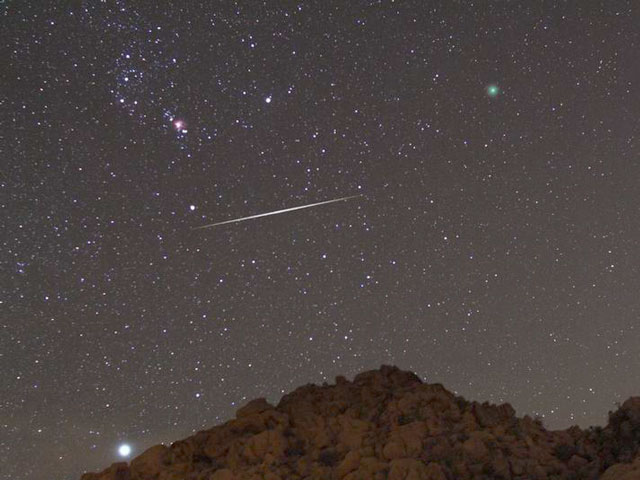Credit & Copyright: Wally Pacholka (Astropics)
Explanation:
Several wonders of the late-year northern sky
appeared together for a few fleeting moments on December 13.
On the bottom left, just above the hill, is blue
Sirius, the brightest star in the sky.
Above Sirius and slightly to the right of the
belt of Orion is the red
Orion Nebula,
one of the most famous nebulas on the sky.
Below and to the right of the
Orion Nebula streaks a yellow meteor,
although moving in the wrong direction to be from the
Geminids meteor shower
that peaked the night.
Finally, above and to the right of the meteor is
Comet Machholz, whose
coma appears here relatively green.
Since the time since this image was taken over a Californian hill, the
Geminid meteor has long since evaporated.
Comet Machholz has brightened and moved to the north.
Sirius, however, will remain in the constellation of Canis Major indefinitely.
News: APOD editor to speak in January in New York
1999 2000 2001 2002 2003 2004 2005 2006 2007 2008 2009 2010 2011 2012 2013 2014 2015 2016 2017 2018 2019 2020 2021 2022 2023 2024 2025 |
Январь Февраль Март Апрель Май Июнь Июль Август Сентябрь Октябрь Ноябрь Декабрь |
NASA Web Site Statements, Warnings, and Disclaimers
NASA Official: Jay Norris. Specific rights apply.
A service of: LHEA at NASA / GSFC
& Michigan Tech. U.
|
Публикации с ключевыми словами:
meteor - Orion - Sirius - Метеор - Орион - Сириус
Публикации со словами: meteor - Orion - Sirius - Метеор - Орион - Сириус | |
См. также:
Все публикации на ту же тему >> | |
